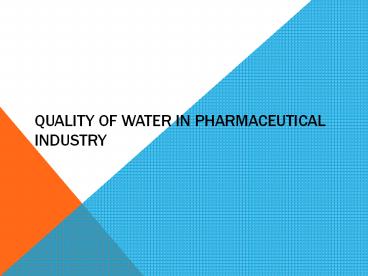Quality Of Water In Pharmaceutical Industry - PowerPoint PPT Presentation
Title:
Quality Of Water In Pharmaceutical Industry
Description:
Water is a key element for numerous pharmaceutical and life sciences processes. As a raw material, water is used in processing, formulation and manufacturing various pharmaceutical products and active pharmaceutical ingredients (API). Most industries rely majorly on surface water and groundwater sources for their pharmaceutical purposes. In its natural state, water from these sources is not free from contamination and needs to be purified before industries use it for pharmaceutical purposes. – PowerPoint PPT presentation
Number of Views:60
Title: Quality Of Water In Pharmaceutical Industry
1
Quality of water in pharmaceutical industry
2
- Water is a key element for numerous
pharmaceutical and life sciences processes. As a
raw material, water is used in processing,
formulation and manufacturing various
pharmaceutical products and active pharmaceutical
ingredients (API). Most industries rely majorly
on surface water and groundwater sources for
their pharmaceutical purposes. In its natural
state, water from these sources is not free from
contamination and needs to be purified before
industries use it for pharmaceutical
purposes.This process of water purification
involves distillation and deionization that
reduces the concentration of contaminated
particles, parasites, bacteria, algae, viruses,
and fungi. It is imperative that water is treated
using proper procedures to ensure its
purity.Depending on the route of administration
of the pharmaceutical product, different grades
of water quality are required. Based on water
quality, below are different types of water for
pharmaceutical use purposes. - 1. Drinking waterDrinking water can be best
described as Potable water. It may be sourced
from a public water utility, a private water
supply (e.g., a well) or a combination of both.
Drinking water is the minimum quality of water
that ought to be used for the preparation of
official substances and other bulk pharmaceutical
substances. The treatment required to make it
safe for human consumption is determined post
evaluating the condition of the source water.
Drinking water, free from contamination is used
for cleaning pharmaceutical manufacturing
equipment and product-contact components. Some
common methods of treatment include
desalinization, softening, deionization, particle
reduction, and reduction of inorganic and/or
organic materials.The equipment and systems used
to produce drinking water, their storage tanks,
3
- distribution pipeworks and the water
quality itself need to be routinely monitored for
environmental, seasonal or supply changes which
may affect the integrity of the water systems in
place. Additionally, techniques such as back
flushing, chemical and /or thermal sanitization
should be put in place to tackle recontamination
of water. - 2. Purified Water Purified water is used mainly
as an excipient in the production of
non-parenteral administrations and in other
pharmaceutical applications. Non-parenteral is
most commonly referred to as the route that oral
medications are administered, therefore it is of
utmost importance that water used for
non-parenteral preparations must meet the
requirements for ionic and organic chemical
purity.Purified water is generally produced by
ion exchange, reverse osmosis, and
ultrafiltration. While producing purified water
it is important to protect it from
recontamination and other microbial protection.
Water treatment company provides sterile plant in
pharmaceutical industry which is useful.































